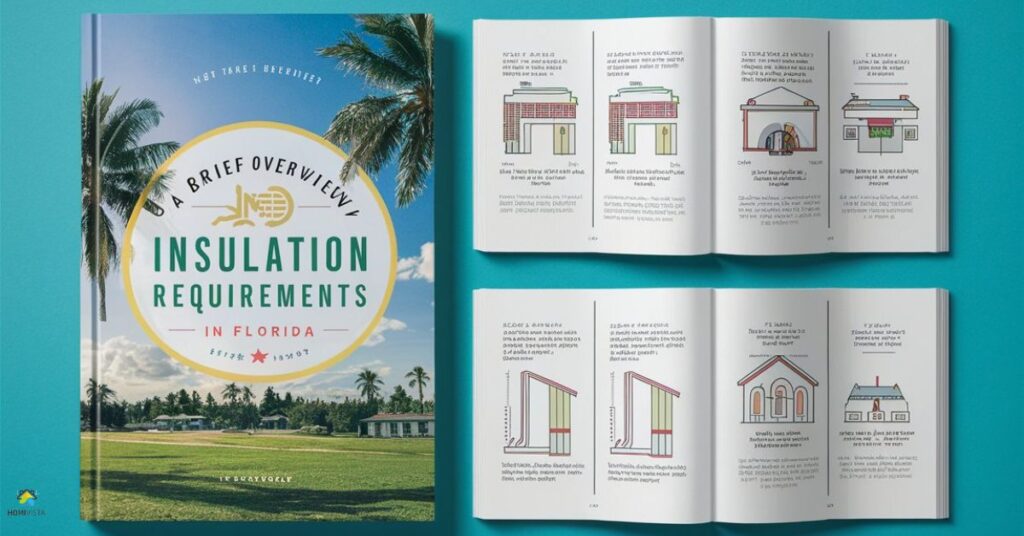A Brief Overview of Insulation Requirements in Florida, provides essential information about insulation needs in the state. Insulation is the material used to minimize heat transfer, keeping homes cool in Florida’s hot climate.
Understanding these requirements is crucial for energy efficiency and comfort. With rising energy costs, proper insulation can lead to significant savings. Learn the right insulation types and levels is essential for homeowners to maintain a comfortable and cost-effective indoor environment in Florida.
What is Insulation
Insulation is a material that reduces heat transfer, keeping homes comfortable. It’s crucial for energy efficiency and cost savings. Different types suit various climates and construction types. Proper insulation reduces energy bills and enhances comfort. Insulating attics, walls, floors and basements is common.
Effective insulation prevents heat loss in winter and keeps cool air in summer. It also improves indoor air quality. Insulation comes in various forms, including fiberglass, foam and cellulose. Insulating pipes and ducts also saves energy. Adequate insulation prevents moisture problems and mold growth.
Quick Facts & Impacts
- Insulation reduces energy consumption by keeping homes warmer in winter and cooler in summer.
- It helps maintain consistent indoor temperatures for comfort throughout the year.
- Proper insulation lowers utility bills by reducing the need for heating and cooling.
- Insulation also contributes to environmental conservation by reducing carbon emissions.
- It improves indoor air quality by minimizing the entry of outdoor pollutants.
- Insulation helps protect homes from moisture damage and mold growth.
- It enhances the overall structural integrity of buildings by preventing temperature-related stress.
- Adequate insulation can increase the resale value of properties.
- Insulation is essential for meeting building code requirements and standards.
- Upgrading insulation can lead to significant long-term cost savings and comfort improvements
Types of Insulation
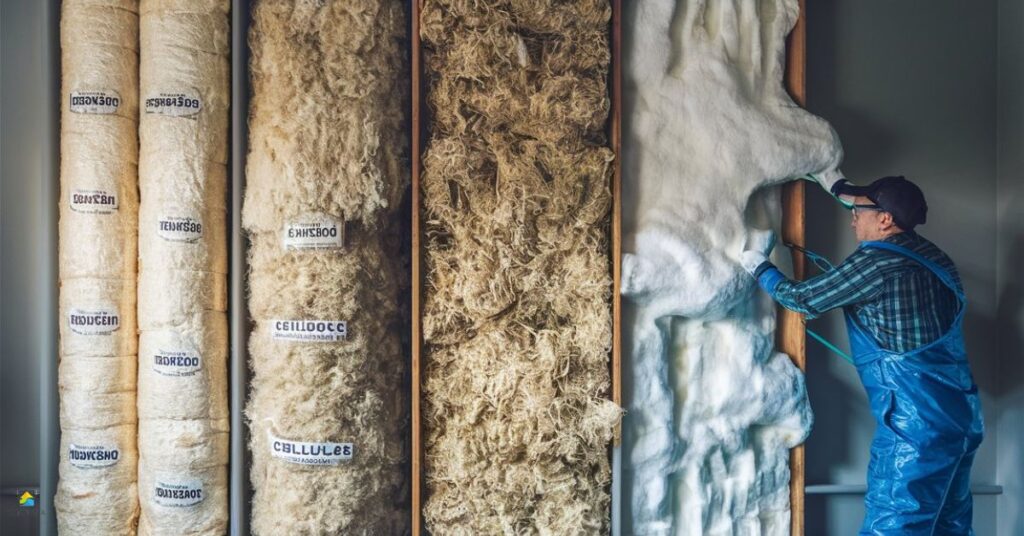
Here are major types of insulation:
Conduction Insulation
Conduction insulation refers to materials that prevent heat transfer through direct contact. Common examples include foam boards and fiberglass batts. These materials trap air pockets, hindering heat flow. Proper installation minimizes heat loss or gain in homes, ensuring energy efficiency. Conduction insulation is vital for maintaining comfortable indoor temperatures and reducing energy costs.
Convection Insulation
Convection insulation involves materials that impede heat transfer through fluid movement, such as air or water. These materials, like loose-fill cellulose or foam sprays, hinder heat flow by disrupting convective currents. Effective installation reduces heat loss or gain, contributing to energy savings and indoor comfort. Convection insulation plays a crucial role in enhancing thermal performance and reducing utility expenses.
Radiation Insulation
Radiation insulation utilizes reflective materials to reflect heat away from the home. This type of insulation, often seen in radiant barriers or reflective foil, prevents radiant heat transfer, keeping indoor spaces cooler in hot climates. By blocking radiant energy, radiation insulation helps maintain comfortable temperatures and reduces cooling costs during warm weather.
Read this blog: Nell’s Cafeteria: A Nostalgic Trip Down Memory Lane – Trash Rite
What Types of Insulation Materials are Available?
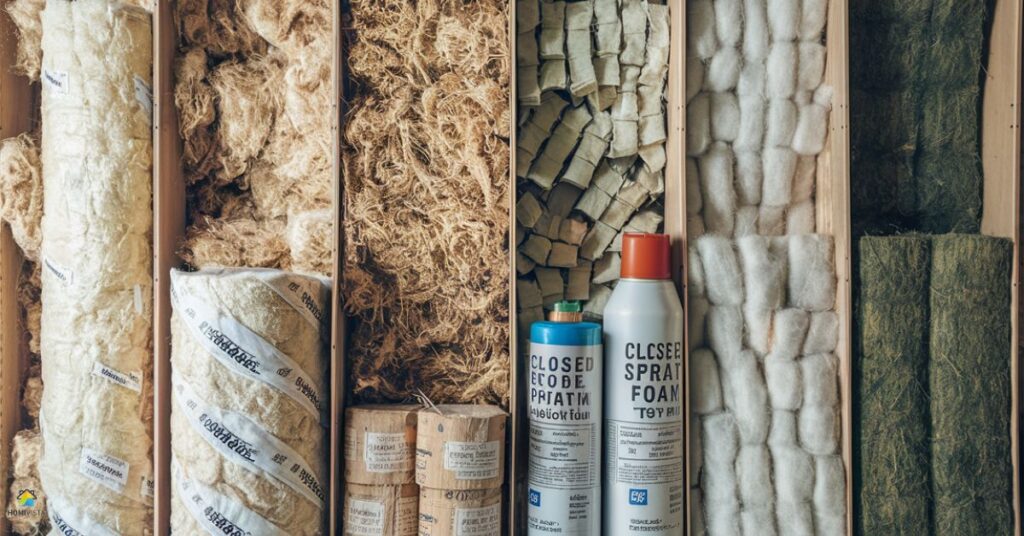
There are several types of insulation materials available for residential and commercial buildings. Some common types include:
Fiberglass Insulation: Made from fine glass fibers, fiberglass insulation comes in batts, rolls, or loose-fill forms and is widely used for its affordability and effectiveness.
Cellulose Insulation: Made from recycled paper or plant fibers, cellulose insulation is eco-friendly and provides good thermal performance.
Foam Board Insulation: This type of insulation is made from rigid foam panels and offers high thermal resistance and moisture resistance.
Spray Foam Insulation: Applied as a liquid that expands into a foam, spray foam insulation creates an airtight seal and provides excellent thermal and moisture control.
Mineral Wool Insulation: Also known as rock wool or slag wool, mineral wool insulation is made from minerals and offers good fire resistance and soundproofing properties.
Reflective or Radiant Barrier Insulation: These types of insulation materials reflect radiant heat away from the living space, helping to keep the interior cool.
Cotton (Denim) Insulation: Made from recycled cotton fibers, cotton insulation is environmentally friendly and provides good thermal and acoustic insulation.
These insulation materials vary in terms of cost, R-value (thermal resistance), installation method and suitability for different areas of the building. Choosing the right insulation material depends on factors such as climate, budget, building structure and insulation needs.
Common Insulation R-Values (Per Inch of Thickness)
| Insulation Material | R-Value (Per Inch) |
| Fiberglass | 3.7 – 4.3 |
| Cellulose | 3.1 – 3.8 |
| Spray Foam | 6.0 – 7.0 |
| Polyurethane Board | 5.6 – 8.0 |
| Rock Wool | 3.0 – 3.3 |
| Reflective Foil | 1.0 – 2.0 |
How Important is Roof Insulation in Florida?

Roof insulation in Florida is crucial for energy efficiency, moisture control and ensuring indoor comfort in a hot and humid climate.
Energy Efficiency
Roof insulation plays a vital role in enhancing energy efficiency in Florida by reducing heat transfer. Its’ minimizing the need for air conditioning and lowering energy bills. It helps maintain a comfortable indoor temperature and reduces the strain on HVAC systems, leading to long-term cost savings and environmental benefits.
Moisture Control
Roof insulation in Florida aids in moisture control by preventing condensation and moisture buildup in attics or ceilings. This helps mitigate the risk of mold and mildew growth, safeguarding indoor air quality and protecting structural integrity. Effective moisture control also contributes to a healthier and more comfortable living environment in homes.
Feel Comfortable
Roof insulation in Florida enhances comfort by regulating indoor temperatures, reducing heat transfer, and minimizing temperature fluctuations. This creates a more consistent and comfortable living environment throughout the year, reducing the need for excessive heating or cooling. Improved comfort levels contribute to a more enjoyable and relaxing home atmosphere for residents.
Environmental Impact
Roof insulation in Florida positively impacts the environment by reducing energy consumption and greenhouse gas emissions. Lower energy usage translates to decreased reliance on fossil fuels and contributes to a cleaner, more sustainable environment. Efficient insulation also helps in preserving natural resources and promotes eco-friendly practices in residential buildings.
Benefits of Roof Insulation for Florida Homes
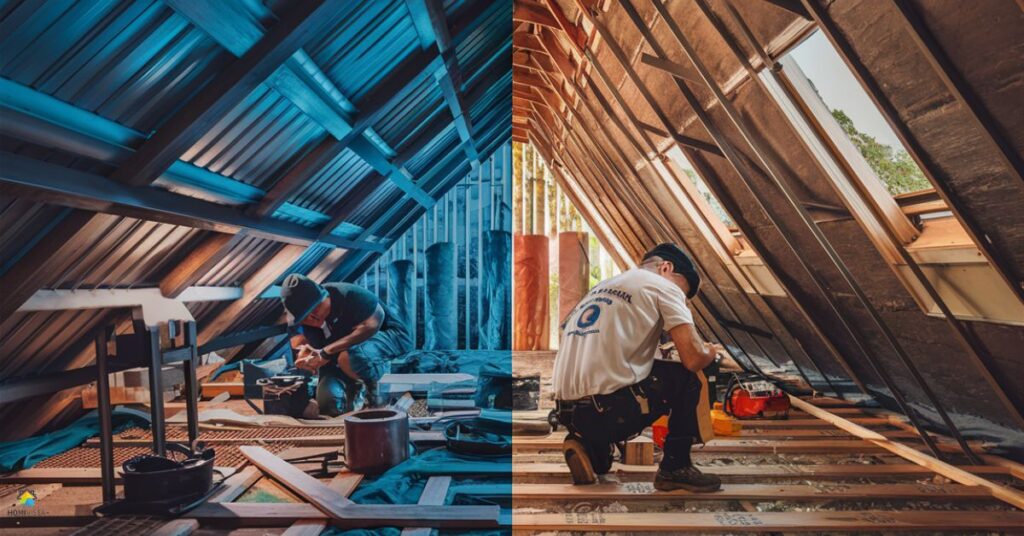
Roof insulation offers numerous benefits for homes in Florida. These benefits make roof insulation a valuable investment for homeowners in Florida, improving comfort, efficiency and overall home value.
Lower Energy Bills: Insulated roofs reduce the need for excessive air conditioning, leading to lower energy consumption and cost savings.
Better Indoor Air Quality: Insulation helps maintain consistent temperatures and reduces humidity, creating a healthier indoor environment.
Extended Roof Lifespan: Insulation protects the roof from extreme temperature fluctuations, prolonging its lifespan and reducing maintenance costs.
Noise Reduction: Insulation can dampen outside noises, creating a quieter and more peaceful living space.
How Can I Determine How Much Wall Insulation is in the Home?
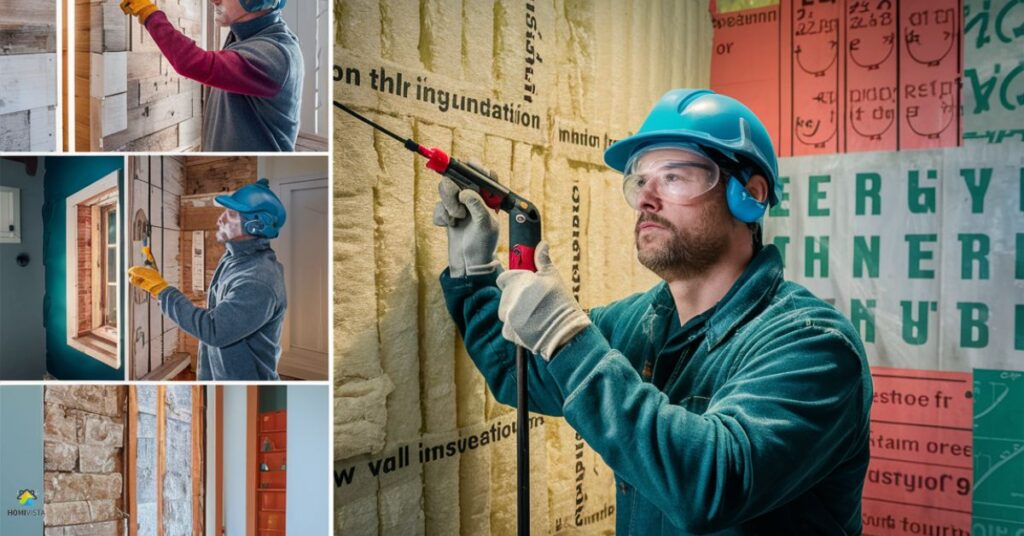
To determine the amount of wall insulation in your home, you can follow these steps:
Visual Inspection: Start by visually inspecting your walls for any visible signs of insulation, such as insulation batts or blown-in insulation visible through openings like electrical outlets or wall switches.
Measure Wall Thickness: Measure the thickness of your exterior walls from the inside. This can be done by removing a wall outlet cover and using a ruler or measuring tape to measure the depth of the wall cavity.
Consult Home Records: Review any documentation or records related to your home’s construction or renovations. These records may provide information about the type and amount of insulation installed in the walls.
Professional Assessment: Consider hiring a professional insulation contractor or energy auditor to conduct an assessment of your home’s insulation. They can use specialized tools like thermal imaging cameras or boroscopes to evaluate insulation levels without causing damage to the walls.
You can gain a better understanding of the amount and type of insulation present in your home’s walls by following the above method.
Some Insulation Installation Tips
Here are some insulation installation tips to ensure effectiveness and safety:
Measure Accurately: Measure the space accurately to determine the amount of insulation material needed. Overestimating or underestimating can lead to waste or insufficient coverage.
Wear Protective Gear: When handling insulation materials, wear appropriate protective gear such as gloves, long-sleeved shirts, pants, goggles and a mask to protect against skin irritation, respiratory issues, and airborne particles.
Seal Air Leaks: Before installing insulation, seal any air leaks or gaps in walls, ceilings and floors to prevent air infiltration and maximize energy efficiency.
Follow Manufacturer Guidelines: Adhere to the manufacturer’s installation guidelines and recommendations for the specific type of insulation being used. This includes proper handling, cutting and fastening techniques.
Maintain Ventilation: Ensure proper ventilation during and after insulation installation to prevent moisture buildup and promote air circulation. Use exhaust fans or open windows as needed.
Avoid Compression: Do not compress insulation materials excessively, as this can reduce their effectiveness. Install insulation snugly but without compacting it to maintain its insulating properties.
Use Vapor Barriers: In areas prone to moisture, such as basements or crawl spaces, consider using vapor barriers along with insulation to prevent condensation and moisture-related issues.
Fire Safety: Follow fire safety guidelines and regulations when installing insulation near heat sources, electrical fixtures, or combustible materials. Use fire-rated insulation materials where required.
Consider Professional Installation: For complex or large-scale insulation projects, consider hiring a professional installer with experience in handling insulation materials and ensuring proper installation techniques.
Inspect Regularly: After installation, periodically inspect the insulation for damage, gaps or signs of moisture. Address any issues promptly to maintain optimal thermal performance and energy efficiency.
Also read: Will Bleach Kill Maggots? A Comprehensive Guide To Getting Rid Of Maggots With Bleach
Most Important Areas of Your Home To Insulate
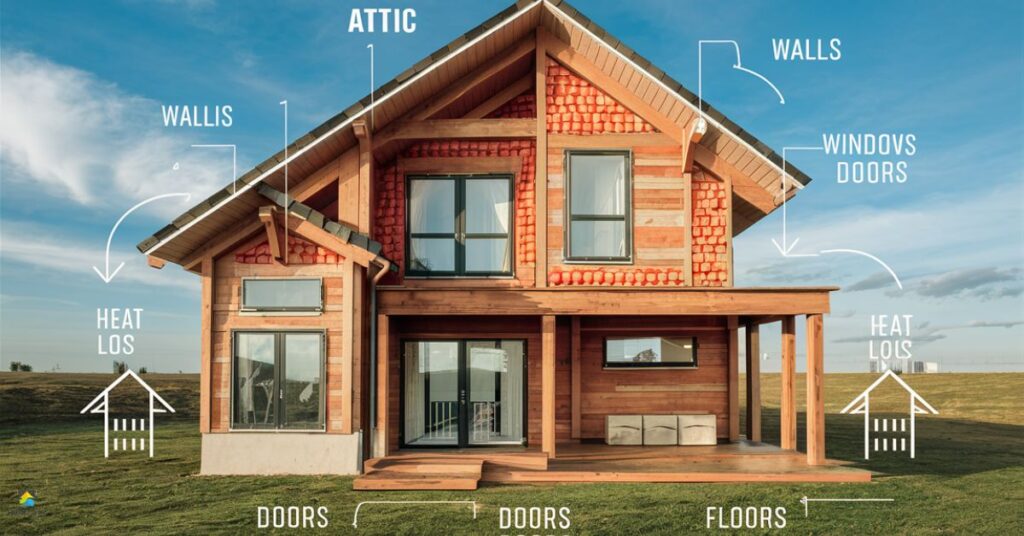
The most important areas of your home to insulate include. Proper insulation in these key areas can significantly impact energy savings, indoor comfort and the overall performance of your HVAC system.
Attics: Insulating the attic is crucial as it helps prevent heat loss in winter and heat gain in summer, improving energy efficiency and maintaining a comfortable indoor temperature.
Basements: Insulating basement walls and floors helps regulate indoor temperatures, prevents moisture buildup. It’s reducing the risk of mold growth and water damage.
Ceilings: Insulating ceilings, especially in rooms directly below attics or unconditioned spaces, helps maintain consistent temperatures and reduces heat transfer between floors.
Floors: Insulating floors above unconditioned spaces such as crawl spaces or garages helps minimize heat loss or gain, enhances thermal comfort and improves energy efficiency.
Walls: Insulating exterior walls improves thermal performance, reduces heat transfer, and enhances overall energy efficiency, contributing to a more comfortable indoor environment.
Benefits of Roof Insulation for Florida Homes
Roof insulation offers numerous benefits for homes in Florida. These benefits make roof insulation a valuable investment for homeowners in Florida, improving comfort, efficiency and overall home value.
Lower Energy Bills: Insulated roofs reduce the need for excessive air conditioning, leading to lower energy consumption and cost savings.
Better Indoor Air Quality: Insulation helps maintain consistent temperatures and reduces humidity, creating a healthier indoor environment.
Extended Roof Lifespan: Insulation protects the roof from extreme temperature fluctuations, prolonging its lifespan and reducing maintenance costs.
Noise Reduction: Insulation can dampen outside noises, creating a quieter and more peaceful living space.
Frequently asked questions
What is roof insulation, and why is it important?
Roof insulation is a material installed in the roof space to regulate indoor temperature, reduce energy consumption and enhance comfort by preventing heat transfer.
How does roof insulation benefit homes in warmer climates like Florida?
Roof insulation in Florida helps maintain cooler indoor temperatures, reduces the workload on air conditioning systems, lowers energy bills and improves overall comfort.
What types of roof insulation materials are commonly used?
Common roof insulation materials include fiberglass, spray foam, cellulose and rigid foam boards, each offering unique benefits in terms of insulation performance and cost.
Can roof insulation help with moisture control in humid climates?
Yes, roof insulation can act as a barrier against moisture infiltration, preventing condensation buildup and reducing the risk of mold and mildew growth in attics and ceilings.
How long does roof insulation last, and does it require maintenance?
Roof insulation can last for decades with proper installation and maintenance. Routine inspections and addressing any damage promptly can help prolong its lifespan.
Is roof insulation a DIY project, or should it be done by professionals?
While some insulation tasks can be DIY, complex projects like roof insulation are best handled by professionals to ensure proper installation, safety and optimal performance.
Does roof insulation have any environmental benefits?
Yes, roof insulation reduces energy consumption, which in turn reduces greenhouse gas emissions, making it an eco-friendly choice that contributes to environmental sustainability.
What factors should homeowners consider when choosing roof insulation?
Factors to consider include R-value (insulation effectiveness), material type, local climate conditions, installation method, cost and long-term energy savings. Consulting with insulation experts can help in making informed decisions.
Conclusion
understanding the insulation requirements in Florida is crucial for homeowners to enhance energy efficiency, maintain comfort levels and reduce utility costs. With the state’s warm climate and high humidity, proper insulation plays a vital role in preventing heat gain, moisture intrusion and air leakage. It’s ensuring a more sustainable and comfortable living environment. Homeowners should consider factors like insulation types, R-values, installation techniques and maintenance practices to make informed decisions that optimize insulation performance and contribute to long-term energy savings.
Staying informed about local building codes, energy efficiency standards, and available insulation incentives can help homeowners navigate the insulation requirements effectively. By prioritizing proper insulation in attics, walls, floors, and roofs, Florida residents can enjoy improved indoor comfort, lower energy bills, and reduced environmental impact, making it a valuable investment for both current and future homeowners.

Meet Harry, our seasoned home decor specialist with three years of hands-on experience. His passion lies in crafting inviting spaces that reflect your style. From cozy corners to vibrant living rooms. Harry’s keen eye for design ensures every detail enhances the overall aesthetic. Trust him to turn your home into a personalized haven, blending functionality with flair.

